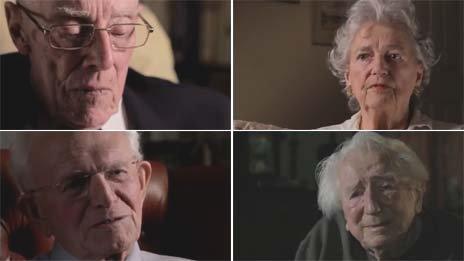Celebrating Colossus, the codebreaking computer
- Published

The film features interviews with four people who helped to bring Colossus to life in World War Two
Testimonials from the last living engineers who worked on the wartime code-cracking machineColossus have been gathered for a film celebrating their work, external.
The codes cracked by the device helped ensure the success of the Normandy invasion that led to the Allied victory in World War II.
Colossus is regarded as being the world's first digital, electronic computer but the story of its creation is not widely known because it was broken up after the war.
The machine was created to speed up analysis of the lengthy messages sent by the commanders of the German army to Hitler.

D Day was a success because the Allies knew Hitler had been fooled about where the invasion would strike
"It meant that our commanders all round the world knew what they were up against because they were given details of the enemy's order of battle which told them exactly what his strengths and weaknesses were," says Ken Halton, an engineer who worked at Bletchley on the code-cracking machines.
Mr Halton says one of the main reasons the Allies successfully launched the D-Day landings was because the cracked messages proved Hitler had been fooled into thinking the invasion would come via the northern Pas De Calais.
The high-level messages were scrambled using what was known as the Lorenz cipher, a code much harder to crack than that used by the Enigma machines. Colossus sped up the statistical analysis of the Lorenz messages.
War work
The film captures the remembrances of four people who worked under senior Post Office engineer Tommy Flowers to build Colossus. Ken Myers, who was seconded from the Post Office research centre at Dollis Hill to work at Bletchley, initially had no idea about what he was helping to build.
"I was assembling and testing some bits and pieces for which purpose I did not know," he says.
Albert Bareham says: "It was merely put to us that we were going to develop some electronic equipment absolutely new to the industry. Nobody had used electronic equipment to code-break."
Once at Bletchley the engineers were let into the secret of what they were creating but few people outside the select group of engineers knew about their work.
Once the design of Colossus had been finalised, young women were recruited to turn out copies of the machine. Margaret Bullen said women were used because their fingers were small and nimble and could wire up the thousands of valves and other components more easily than men.
Each finished machine had about 2,500 valves arranged across racks more than two metres tall. In total, 10 machines were built.
Hidden history
All the Colossus veterans, like many other Bletchley workers, were sworn to secrecy and many waited decades before telling friends and family what they had done. Mr Myers did not reveal the news to his wife until the 1970s.
It was about this time that information about Bletchley Park and Colossus began to circulate leading to the realisation that the machine, which first ran in December 1943, was the first electronic, digital programmable computer.
This hiatus, brought about by the order to stay silent and the destruction of almost all the working Colossi at the end of the war, has led the machine and its creators to be overlooked, says Phil Hayes, the chief engineer at the National Museum of Computing who looks after a re-built Colossus.
"If you take the logic elements out of a processor of today, it's made up of logic gates, and those gates are found on Colossus for the very first time. This is why it's the first electronic computer," he tells the BBC.
"It should get more recognition, it has been kept in the dark," he adds. "Everybody knows about Enigma, but Colossus is far more sophisticated. There's a big story to be told about how the code was broken."
Google has been behind the project to film the Bletchley engineers and has posted the movie on its video-sharing site YouTube.
Peter Barron, head of external relations at the search giants' UK division says his firm owed the Bletchley engineers a debt of gratitude.
"The engineers who work at Google, both in the UK, in the US and around the world have a great affinity to Bletchley Park and the work of Alan Turing," he says. "Really because the early ideas of computing, the early ideas of the algorithm were developed there."
The Colossus film is the second that Google produced about historical computers and those who created them.In November 2011, it published a film about the Leo, the world's first business computer, external.
The film has been released just as the gallery housing the re-built Colossus at The National Museum of Computing in Bletchley Park is undergoing a refit.
The five-week project will mean visitors will be able to see more of the machine. Eventually the gallery will be outfitted with multimedia displays explaining how it was created.
- Published8 February 2012
- Published9 March 2012
- Published13 September 2010
- Published26 May 2011